
Licensed
Workers (Accredited Lay Workers)
| Miss Emily FitzHardinge Berkeley will be remembered by many readers of this magazine, although failing health brought her active work in the parish to an end four years ago. She was a considerable sufferer but managed to keep in touch with many of her old friends till the end. When able to go out, she has attended St. Paul's, Shadwell, finding the steps up to St. George's a serious matter owing to her weak heart. She was a most Devoted worker, always willing to spend herself and all she has for Christ, but never, if she could help it, a penny upon herself. Her example will long live with us. |
| Miss P.M. Hatton has
left us after 5½ years of most strenuous service in the parish. The
Diocesan Board of Women's Work announced that for two years they have
regarded her as just the person for their work, and that they had
thought this a good opportunity of securing her services. She entered
upon her duties at the London Diocesan House, 33 Bedford Square, at the
beginning of March. She has our best wishes for her health and strength
and success in her new work. Miss Hatton was specially approved by the
Bishop of Stepney for the task of organising the Social Service of this
parish, She had charge of the joint Children's Care Committee Office at
136 St. George Street, where the arrangements for securing treatment
for the ailments of the children attending the Highway, Blakesley
Street, Lower Chapman Street, Cable Street Central, and the Lowood
Street, Cable Street and Berner Street Special Schools [a mix of 'P.H.' - physical
handicap - and 'M.D' - mental deficiency schools - see here for more details] were
made. This work involves an enormous number of visits to the homes of
children residing in the area (with the result, among others, that this
is one of the best visited parishes in London), besides a huge
correspondence with the London County Council (several departments),
hospitals, treatment centres, and kindred agencies, such as the Invalid
Children's Aid, Tuberculosis Care Committee, Skilled Employment
Committee, War Pensions Committee, Juvenile Advisory Committee, and the
like. No one without Miss Hatton's wide knowledge and experience could
have undertaken the task. No one without her remarkable agility,
energy, and speed of work, could have brought the work up to the high
standard of efficiency to which, at no small sacrifice to her health,
and with a complete sacrifice of leisure and other ties, she managed to
bring it. The work in our office at 136 St. George's Street can safely challenge comparison with any work of the kind in England, and this we owe to Miss Hatton. Her work for the Rangers, and Guides and their Camp, was undertaken by her as a form of recreation! and was quite outside the circle of duties the Bishop sent her here to perform, but it was none the less appreciated by him. We desire to tender to her our grateful thanks, not unmixed with anxiety lest her strenuous years at St. George's may have made grave inroads upon her strength. |
| During the 15
months that she has been amongst us she had worked unceasingly for the
welfare of Pell Street Club, and few of its members can know how much
time and thought she had given to it and to them. Her Sunday School
class will miss her sadly, and the Wolf Cubs will perhaps mourn her
departure most of all. For she has been the creator of the St. George's
Pack, and very dear indeed has it been to her heart. We can only
offer her our sincerest sympathy that an unfortunate accident had ended
her work here, and our hopes for an early and complete recovery, and
success in whatever work she undertakes in Ireland. |
| Margaret
E. Hallward was born in Frittenden Rectory in 1868, one of a family of
eleven. Her father who was Rector there found in her a valuable worker,
but her conception of the service of Christ and her fellows involved,
as she believed, more sacrifice of her personal inclination than this
entailed. In 1900 her brother, John, was curate to the Rev. Arthur
Dobson, Rector of Stepney, and Margaret joined the splendid band of
workers the Rector had gathered around him to maintain the tradition of
Church effort for which the Parish was already famous. She worked there
for seven years; but them on the death of her father, she thought she
ought to rejoin her family, and settled with them at Buxted, Sussex,
and later at Frittenden. When her mother died in 1915 Margaret Hallward
took up work for the Y.M.C.A. in the great Camp at Havre and remained
there till 1919. In 1921 she felt again the appeal of the great task
she had laid down for family reasons in 1907, and, believing she could
do something to befriend some, perhaps many, of the East Londoners she
had got to know and love in khaki at Havre, returned to Stepney. This
time it was to a different Parish. The Rector of St. George-in-the-East
was an old school friend of her brother John. She offered for work
there and the offer was accepted with enthusiasm, and the work which
she then undertook she was carrying on at full pressure up to within a
few hours of her sudden death. So much for the chronology of a life which in the remaining space available we will endeavour to appreciate. There was no small significance in Margaret Hallward's taking up residence at 35 Prince's Square. The house had been the home for many years of her aunt, Miss Caroline Hoare. It meant, therefore, the maintenance of a family tradition of social service. Both she and her aunt belonged in fact to one of those great and powerful clans of philanthropists which have been among the strongest and most splendid elements of English social life for two centuries. There were not a few points of resemblance in the characters of aunt and niece. Both were powerful and extremely courageous personalities. Both of them combined with all this force and determination a questioning spirit - a rare combination. Both of them cherished really deep attachments to those among their less fortunate neighbours with whom they became acquainted. It was possible to observe in the working of Margaret Hallward's mind and in her activities the extent of the change which has come over both social philanthropy and philanthropic effort since she took up work in East London in 1900. In 1900 a parochial organisation like that of Stepney Parish Church was, apart from the Poor Law, practically the only agency on the spot for succour, uplift and amelioration. The Rector and his staff accepted the position as a permanent one and were out to build up means of rendering these services more and more effectually and for more and more people every year. They appealed confidently to all good people who believed in the future well-being of England to give them unstinted aid in money and effort. When Margaret returned to work in 1921 the Parochial situation had been completely revolutionised. An immense and complicated variety of public machinery had been set up to carry out the very objects for which she and her colleagues had worked at Stepney twenty years before. At the same time for a variety of reasons most thinking people had begun to question alike the wisdom and necessity of voluntary gifts and voluntary effort. Many were asking whether there out to be people with any surplus of money or time. Margaret Hallward felt the full weight and significance of these changes, She was equally content to take her place performing small functions in a big piece of public machinery like the School Care Committee Organisation, and to spend an afternoon listening to the schemes of her "Labour" acquaintances for turning the social fabric upside down. But all the while she was demonstrating triumphantly that all the philosophic questioning and all the administrative developments had failed between them to produce anything of equal value with personal work and home visiting based upon love of God and man. The wonderful thing about her was that with all her own strength and deep moral sense she could cling with an unconquerable optimism to the belief that the apparently feeble and incompetent would prove themselves one fine day, if only given a chance, strong and efficient., It is hardly necessary to add that she was a worker of quite unique value in a Parish like St. George-in-the-East. Her questioning attitude in social economics did not shake her strong Churchmanship or her unflagging zeal as a Sunday School and Bible Class teacher, She brought into the grimy surroundings of St. George's her great love of beautiful things, whether in the gardens of Kent, the snows of Switzerland, or the Lakes and Cities of Italy. She loved these things in proportion as they could be made available for her friends, and at the time of her death had just refused to accompany her sisters on a long Italian holiday rather than leave those whom she knew so well to befriend under the shadow of London Dock wall. One of the many delightful aspects of her service was her genius for bringing other members of her family and clan into it. Her fellow workers will not readily forget the frequent appearances of the Hallward and Hoare connection laden with country produce for decorations or sustenance. All those who loved her, and in forlorn and hesitating moments loved to lean upon her great strength and firmness of purpose, are thankful that she passed so swiftly and painlessly to the next stage of her service for the Master; but if we dare repine we would fain ask "Lord why so soon?" J.C.P. |
| My dear
Rector, I wish I could have been with you and your people tomorrow
evening, but it is impossible. St. George's parish has had in Miss
Hallward one for whose presence, influence and work they will always
thank God. Those who like myself have known her at all intimately will
say: "Every thought of her is blessed, every memory good." Her love,
her influence, must continue. Death cannot destroy them. There is the
momentary shock and bereavement, but in Christ there is greater love,
life and service. Tell her many friends how real is my sympathy with
them. Yours very sincerely, HENRY STEPNEY. |
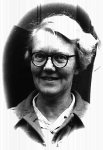 Nora
had trained for parish work at St Andrew's House [see below], and
served as a
licensed worker in Hackney before coming to St George-in-the-East. She
arrived in 1943, to join the wartime team under Fr Groser that was maintaining ministry
to a blitzed and struggling community. Her home was at St John's House, 13 Christian Street. Among other things, she ran a club for
girls, many of them 'coloured' (as they would then have said). Olive Wagstaff remembers being
sent as a student in 1948 for training in visiting and club
work,
where she first met Nora. Her encounter with the club was a new
experience for her. When
sending me to visit she always gave me a church magazine and other
literature to take as an introduction, which was a valuable lesson in
communication. After further moral welfare training, she worked at St Michael London Fields.
Nora
had trained for parish work at St Andrew's House [see below], and
served as a
licensed worker in Hackney before coming to St George-in-the-East. She
arrived in 1943, to join the wartime team under Fr Groser that was maintaining ministry
to a blitzed and struggling community. Her home was at St John's House, 13 Christian Street. Among other things, she ran a club for
girls, many of them 'coloured' (as they would then have said). Olive Wagstaff remembers being
sent as a student in 1948 for training in visiting and club
work,
where she first met Nora. Her encounter with the club was a new
experience for her. When
sending me to visit she always gave me a church magazine and other
literature to take as an introduction, which was a valuable lesson in
communication. After further moral welfare training, she worked at St Michael London Fields.
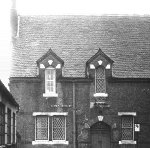
 In 1957 (officially licensed the following year) Nora became the first worker at Church House,
Wellclose Square
with Fr Joe Williamson,
having first spent a period doing additional training in 'moral welfare
work'. Initially she lodged with Mrs Maaser at 4 Wellclose Square -
more than
once giving up her bed to a young girl off the streets - but in due
course moved into Church House itself. (Curiously, she is listed in
diocesan archives of the period as 'Miss D.J.H. Neal'.) In the
following year, as the
work expanded, she was joined by Daphne Jones (see below). The pictures
show Church House, and residents in the common room in the 1960s. In
the words of Brother Bernard SSF in his Church Times obituary of 23 November 1992 [pictured], the MBE which followed her retirement brought joy to many and astonishment to her.
In 1957 (officially licensed the following year) Nora became the first worker at Church House,
Wellclose Square
with Fr Joe Williamson,
having first spent a period doing additional training in 'moral welfare
work'. Initially she lodged with Mrs Maaser at 4 Wellclose Square -
more than
once giving up her bed to a young girl off the streets - but in due
course moved into Church House itself. (Curiously, she is listed in
diocesan archives of the period as 'Miss D.J.H. Neal'.) In the
following year, as the
work expanded, she was joined by Daphne Jones (see below). The pictures
show Church House, and residents in the common room in the 1960s. In
the words of Brother Bernard SSF in his Church Times obituary of 23 November 1992 [pictured], the MBE which followed her retirement brought joy to many and astonishment to her. Nora began retirement as warden at Megg's and Goodwin's
Almhouses (founded by Meggs in Whitechapel Road in 1658, 'repaired,
improved and further endowed' by Benjamin Goodwin and rebuilt in 1893
in Upton Lane, Forest Gate). She returned to Stepney, first to a bedsit in Tredegar Square and then to a
flat at Toynbee Hall, where, as Olive Wagstaff says, she was a great
help and encouragement to all her friends and neighbours. At the ago of 80 she
moved to Compton Durville in Somerset, the mother house of the Community of St
Francis - she was a Franciscan tertiary for 46 years. She
played an active role in the House, helping novices and visitors, and
when she died there, aged 91, was buried in the grounds.
Nora began retirement as warden at Megg's and Goodwin's
Almhouses (founded by Meggs in Whitechapel Road in 1658, 'repaired,
improved and further endowed' by Benjamin Goodwin and rebuilt in 1893
in Upton Lane, Forest Gate). She returned to Stepney, first to a bedsit in Tredegar Square and then to a
flat at Toynbee Hall, where, as Olive Wagstaff says, she was a great
help and encouragement to all her friends and neighbours. At the ago of 80 she
moved to Compton Durville in Somerset, the mother house of the Community of St
Francis - she was a Franciscan tertiary for 46 years. She
played an active role in the House, helping novices and visitors, and
when she died there, aged 91, was buried in the grounds.| On
my bookshelves I have a book of which I am very fond. It is a book of
photographs of East London and it has one of 13 Christian Street,
Stepney. That was the place that I first met Dorothy Halsall. It was
not a chance meeting for me. I was at the time at William Temple
College, where I had met a close friend of Dorothy's who had worked
with her in Sheffield. She knew that Dorothy was working in the parish
of St George-in-the-East but was about to move to the Royal Foundation
of Saint Katharine to work with Father John Groser, and so it came
about that I replaced Dorothy at St George's, and thus a strong and
lasting friendship was established. I learned so much from her seeing
how she related to others of all descriptions - the young, the elderly,
the tough seafaring men coming to be in the house run by the Franciscan
brothers on Cable Street just around the corner from Christian Street.
But for the eight years that I was there it was her work with the
elderly people that made the strongest impression on me. She was
regularly at a lunch club held in the hall at St George's, where the
people loved her and where she was happy to give them advice when they
asked for it, but never patronised them. All over the area there were
and still may be people who are deeply indebted to Dorothy for the help
and care she gave them, and within the Foundation itself she could
always be found by women workers like myself who were thankful to
consult her about their work and its problems, which were never in
short supply. It was a real joy to many when she was in the Queen's New
Year's Honours List - so well deserved. Her Christian faith was always
deeply important to her and many years later when I visited her in
Havant it was very moving to discover the reality of her prayer life
and the inclusion of so many friends – those from the past as well as
many new friends, and many world-wide causes and prayers for world
peace. |
| We
used the big room on the ground floor for meetings and discussions and
for a place where children could come after school … The house was just
round the corner from Cable Street and near the Franciscan house
where the brothers ran a club for men who worked on the ships that
would come into the docks, and Father Neville used to come to the staff
meetings on Monday mornings at the Rectory. Opposite the house … was Christian Street School
(run by the London County Council), and next to the house a small
synagogue where the Jewish children went for instruction and not far
away was Fairclough St School [now Harry Gosling School], also
run by the LCC … which kept the Jewish festivals and started early on
Fridays and finished early so that the Jewish Sabbath could be
observed. From the start of my time in Stepney I went twice a week in
the mornings to teach the Christian children scripture. The Church itself when I came was a pre-fab within the stone walls of the original church which had been seriously damaged by the bombing. There was a said Eucharist each morning, and on Sundays a Sung Eucharist at 9.30am with a Eucharist at 11.30am for the children, with a kind of commentary for the children to help them to understand what it was all about. I did a lot of visiting of the families of the children who came to church. During that time I arranged to take a group of children to an old house in a village in Hampshire which had a garden on the river Test where my mother was born and some member of her family had lived for the last 300 years … It was a great time for all of us and especially for me since I had spent a lot of time there as a child. |
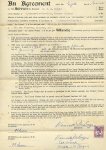 was
a friend of Mary Dudman from William Temple College, and had qualified
as a teacher at Leeds University in 1953. She came initially to the
Royal Foundation of St Katharine's, but the work was not what she
expected so she transferred here in 1955. She lived in rooms on the
first floor of the Mission House, 181 The Highway, and was paid a
salary of £330
a year (later reduced to £315). Right is
a copy of the agreement under which she, like other lay workers of the
time, were employed: a probationary period of three months; three
month's notice by the incumbent (except that on a change of incumbent
either party could give six weeks' notice); answerable directly to the
bishop during a vacancy; and arrangements for holidays, sickness,
insurance and pension. Edith
Wyeth's daughter Jenefer (who had a holiday with 'Hawky' and her niece
on the Isle of Wight, where her family came from) remembers her as a jolly lady, maybe a little eccentric, who would do anything for anybody. One of her duties was cleaning the prefab,
and she showed Jenny how to remove candle wax from carpets with brown
paper and a hot iron, and also how to sweep the dirt through a loose
floorboard into the void below. Like many of her ilk, she kept a bottle
of smelling salts in her bag.
was
a friend of Mary Dudman from William Temple College, and had qualified
as a teacher at Leeds University in 1953. She came initially to the
Royal Foundation of St Katharine's, but the work was not what she
expected so she transferred here in 1955. She lived in rooms on the
first floor of the Mission House, 181 The Highway, and was paid a
salary of £330
a year (later reduced to £315). Right is
a copy of the agreement under which she, like other lay workers of the
time, were employed: a probationary period of three months; three
month's notice by the incumbent (except that on a change of incumbent
either party could give six weeks' notice); answerable directly to the
bishop during a vacancy; and arrangements for holidays, sickness,
insurance and pension. Edith
Wyeth's daughter Jenefer (who had a holiday with 'Hawky' and her niece
on the Isle of Wight, where her family came from) remembers her as a jolly lady, maybe a little eccentric, who would do anything for anybody. One of her duties was cleaning the prefab,
and she showed Jenny how to remove candle wax from carpets with brown
paper and a hot iron, and also how to sweep the dirt through a loose
floorboard into the void below. Like many of her ilk, she kept a bottle
of smelling salts in her bag.  After another parish post, she went to
work at Boston High School for Girls in Lincolnshire (founded 1921, moving to its present site in 1939 - left
- and now a selective Academy); there she was the local rep for the
Assistant Masters & Mistresses Association. She retired to
Whittington College, sheltered housing provided by the Mercers'
Company, on the London Road in Felbridge, East Grinstead, where Edith visited her on several occasions.
After another parish post, she went to
work at Boston High School for Girls in Lincolnshire (founded 1921, moving to its present site in 1939 - left
- and now a selective Academy); there she was the local rep for the
Assistant Masters & Mistresses Association. She retired to
Whittington College, sheltered housing provided by the Mercers'
Company, on the London Road in Felbridge, East Grinstead, where Edith visited her on several occasions.| 2 February 1974 (when
asked to take on St Botolph's) There is a verger, Peter, and a tiny Germanic lady worker Trudie Eulenberg who is abrupt and, as Bishop George Appleton a former rector observed, not everybody's cup of tea but a brand of her own. |
| A seated statue of the
Virgin Mary was brought back from Walsingham earlier this year by the
parish pilgrims led by David Randall. Half the congregation hated it
and half loved it … Trudie Eulenburg, our parish worker, calls the
statue ze doll on ze shelf, because as I didn’t know where to
put it I placed it on a window sill. Today one of our crypt men threw
it on to the floor breaking it into smithereens. Half cheered, half
cried. |
| 10 April 1982 Trudie Eulenberg, our parish worker, phoned to say her father, 103, has died, so I drove immediately to be with her at her house in Harrow. She has been bullied by him for all her life and when I said prayers by his corpse I was surprised to see how tiny he is. He owned the Eulenberg music publishing business in Germany, but because he was a Jew he had to leave it and flee to Switzerland in 1939. After the war, then aged 68, he started the business again in this country. |


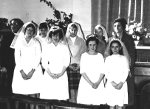 Morwenna Tredinnick
Morwenna Tredinnick
 Olive
was licensed as an accredited worker in 1949 (we celebrated her 60th anniversary in 2009), and has been part of our parish
life for many years both before and after her retirement, serving for
various periods both as
churchwarden and sacristan, and leading worship at St Paul Dock Street prior to its closure. She began her training at Selly Oak (for
she is a Brummie), and after a further two years training with the
Ranyard Mission worked at St Dunstan Stepney from 1949-53 - see her article in their magazine [left] for
a restrospect of those days, interesting both for the heavy
expectations laid on women workers and for what, ridiculously, they
were barred from doing. She then became one of the original members
of the resident lay community at the Royal Foundation of St Katharine
under Fr Groser. From here she was seconded to help run Stepney Old
People's Welfare, leaving St Katharine's in 1964 to work from Limehouse
Town Hall, and the following year (after local government
reorganisation) from Toynbee Hall, where she lived for some years,
running the Senior Care and Leisure Centre, which was based in Attlee
House opened by the Queen in 1971. Right is an account of this work from the Hackney Gazette of 9 January 1973.
Olive
was licensed as an accredited worker in 1949 (we celebrated her 60th anniversary in 2009), and has been part of our parish
life for many years both before and after her retirement, serving for
various periods both as
churchwarden and sacristan, and leading worship at St Paul Dock Street prior to its closure. She began her training at Selly Oak (for
she is a Brummie), and after a further two years training with the
Ranyard Mission worked at St Dunstan Stepney from 1949-53 - see her article in their magazine [left] for
a restrospect of those days, interesting both for the heavy
expectations laid on women workers and for what, ridiculously, they
were barred from doing. She then became one of the original members
of the resident lay community at the Royal Foundation of St Katharine
under Fr Groser. From here she was seconded to help run Stepney Old
People's Welfare, leaving St Katharine's in 1964 to work from Limehouse
Town Hall, and the following year (after local government
reorganisation) from Toynbee Hall, where she lived for some years,
running the Senior Care and Leisure Centre, which was based in Attlee
House opened by the Queen in 1971. Right is an account of this work from the Hackney Gazette of 9 January 1973. 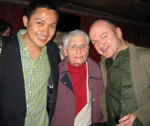
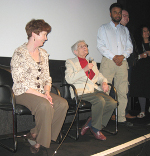
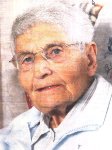
 Olive's
home for many years has been the 22nd floor of Shearsmith House on the
St George's Estate, from which she has seen it all happen (including
the 'Siege of Wapping' in 1986). In 2010 she was one of five long-term Tower Hamlets residents, from different faith communities, featured in a film East End Lives by Hazuan
Hashim and Phil Maxwell [left with its makers, and answering questions at the launch]. In her final years, having campaigned
vigorously for the elderly of the area for much of her life, was
herself a recipient of its social services, and comments on the
experience in an article [right] from East End Life (6 June 2011); she died in June 2015.
Olive's
home for many years has been the 22nd floor of Shearsmith House on the
St George's Estate, from which she has seen it all happen (including
the 'Siege of Wapping' in 1986). In 2010 she was one of five long-term Tower Hamlets residents, from different faith communities, featured in a film East End Lives by Hazuan
Hashim and Phil Maxwell [left with its makers, and answering questions at the launch]. In her final years, having campaigned
vigorously for the elderly of the area for much of her life, was
herself a recipient of its social services, and comments on the
experience in an article [right] from East End Life (6 June 2011); she died in June 2015. 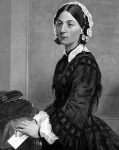 In the 19th century London pioneered the training of women
for lay
parochial ministry, with several diocesan or local institutions. Most
of them were initially associated with the development
of deaconess
ministry, which was much-influenced by the community-based model of the
Kaiserwerth movement in Germany (where Florence Nightingale [left]
trained; some of its members nursed at the German hospital in East
London opened in 1845). Some
institutions specialised in nursing (see the note above on the Nursing Sisters of St John the Divine,
which ran training programmes for 'lay' midwives), some in visiting and
general
parochial work,
some in teaching. Across London there were a
number
of 'settlements' where women workers lived.
In the 19th century London pioneered the training of women
for lay
parochial ministry, with several diocesan or local institutions. Most
of them were initially associated with the development
of deaconess
ministry, which was much-influenced by the community-based model of the
Kaiserwerth movement in Germany (where Florence Nightingale [left]
trained; some of its members nursed at the German hospital in East
London opened in 1845). Some
institutions specialised in nursing (see the note above on the Nursing Sisters of St John the Divine,
which ran training programmes for 'lay' midwives), some in visiting and
general
parochial work,
some in teaching. Across London there were a
number
of 'settlements' where women workers lived.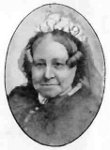 One
of the earliest, and most innovative schemes – for it provided the
first
paid social workers, and then district nurses – began in 1857 as
the London Bible and Domestic Female
Mission. Ellen
Ranyard (1809-79)
was the daughter of a London cement maker, and as a child encountered
the homes of the poor. Her organisation first trained working-class
women in 'poor law, hygiene and scripture' to become 'bible women' in
their home areas - a cross between missionaries and social workers –
under the supervision of middle-class superintendents. By 1867 there
were 234 workers across London. To this were added, the following
year, 'bible nurses': also working-class women, with hospital
training. By 1894 a team of 80+ made over 200,000 visits a year.
Nursing training ended in 1907 as hospitals took on the
role, but Ranyard Nurses continued to make a contribution up to and
beyond the introduction of the NHS. Renamed the Ranyard Mission in
1917, and based in the Holborn area, it continued to train women for
parish work. The Friends of Ranyard now run homes in Blackheath -
Mulberry House, Dow House and Kingswood Halls. Olive Wagstaff trained here, and found it a rich experience; so too did Trudi Eulenberg. Although numbers after the war were small, they
drew on all the resources of London – lectures at King's College
and SOAS, and site visits to places such as courts, hospitals and even
waterworks.
One
of the earliest, and most innovative schemes – for it provided the
first
paid social workers, and then district nurses – began in 1857 as
the London Bible and Domestic Female
Mission. Ellen
Ranyard (1809-79)
was the daughter of a London cement maker, and as a child encountered
the homes of the poor. Her organisation first trained working-class
women in 'poor law, hygiene and scripture' to become 'bible women' in
their home areas - a cross between missionaries and social workers –
under the supervision of middle-class superintendents. By 1867 there
were 234 workers across London. To this were added, the following
year, 'bible nurses': also working-class women, with hospital
training. By 1894 a team of 80+ made over 200,000 visits a year.
Nursing training ended in 1907 as hospitals took on the
role, but Ranyard Nurses continued to make a contribution up to and
beyond the introduction of the NHS. Renamed the Ranyard Mission in
1917, and based in the Holborn area, it continued to train women for
parish work. The Friends of Ranyard now run homes in Blackheath -
Mulberry House, Dow House and Kingswood Halls. Olive Wagstaff trained here, and found it a rich experience; so too did Trudi Eulenberg. Although numbers after the war were small, they
drew on all the resources of London – lectures at King's College
and SOAS, and site visits to places such as courts, hospitals and even
waterworks. |
Mrs. Ranyard, in her Missing Link Magazine, states that the supporters of ihe Bible Women's Mission have enabled her to maintain, during the past year, 222 Bible women. The total receipts last year were £17,179; the total expenditure, £17,414. The donations to special districts and to the general or working fund were £11,808 17s l0d. The lady superintendents received in payment from the poor last year: For Bibles, £785 5s 8d; for clothing, beds, soup, £4,584 17s 6d; total payments from the poor, £5,370 3s 2d. The expenditure of the mission includes: For salaries to Bible-women, £6,865 18s 9d; payments for Bibles, £698 16s 7d; returned to the poor in clothing material and by payments for work, £4,926 15s; and rent and furniture, with light and fire in Mission-rooms, £2,221 6s Id. The mission has supplied nine Bible-women to country districts. Thirteen women have been trained with the Bible-women previous to their hospital training as nurses. The mission has paid salary from its foreign fund in aid of native Christians employed as Bible-women abroad, or for purely Bible work. It has six Bible-women in Beyrout and Damascus, twelve at Ooroomiah (in Persia), three or four in India and Burmah, two in Madagascar, one in Jerusalem, two in Lodiana, one in Marseilles, one for the French at New York, one in Jamaica, one in Demerara. Within the last fourteen years there has passed through the hands of the Lady Superintendent of the mission for various Bible mission purposes a sum not far short of two hundred thousand pounds: £116,874 in voluntary donations to the first work; £10,646 payments of the poor for Bibles; £58,790 for clothing from the poor; total £186,310. £5,257 for mother-house and Bible-women nurses, inclusive of £1,309 spent in food, clothing, &c., to patients; £5,091 for Dudley-street and Parker-street dormitories; £1,054 for Mr. Moon's Bibles for the blind; and £2,065 for foreign fund to place Bible-women on foreign stations when providentiul openings occur: total £199,777. |

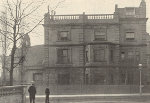 In 1861 Elizabeth Catherine Ferard (from a Huguenot family), encouraged
by Bishop Tait of London to visit deaconess institutions in Germany,
gathered a group of women who dedicated themselves to minister to the necessities
of the church,
and the following year the bishop gave her the first licence as a
deaconess in the Church of England (though the ministry was not
recognised until 1897, and did not become an 'order' until 1923). Her
North London Deaconess Institution began in Burton Crescent,
King's Cross in 1861, serving the Great Northern Hospital; its 'house
rules' were very like those of a religious community, and their
chaplain was the Revd Thomas Pelham Dale,
who was later prosecuted, and
imprisoned, for ritualism offences. In 1873, as the London Diocesan
Deaconess Institution, they moved to St
Andrew's House
in Tavistock Crescent, Notting Hill [right], where for the next 18
years
they ran a nursing home, and then, having acquired the adjacent house,
St Gabriel's Home training destitute girls for domestic service, until
1897. It then became enlarged premises for the community, which was
renamed the Deaconess Community of St Andrew in 1943, and offered
training. In 1974, a new building including student accommodation was
created. CSA (now including priests and well as deacons and
deaconesses) continues,
and their premises house the worldwide Anglican Communion office. The Church of England calendar commemorates Elizabeth Ferard as 'first deaconess of the Church of England' on 18 July.
In 1861 Elizabeth Catherine Ferard (from a Huguenot family), encouraged
by Bishop Tait of London to visit deaconess institutions in Germany,
gathered a group of women who dedicated themselves to minister to the necessities
of the church,
and the following year the bishop gave her the first licence as a
deaconess in the Church of England (though the ministry was not
recognised until 1897, and did not become an 'order' until 1923). Her
North London Deaconess Institution began in Burton Crescent,
King's Cross in 1861, serving the Great Northern Hospital; its 'house
rules' were very like those of a religious community, and their
chaplain was the Revd Thomas Pelham Dale,
who was later prosecuted, and
imprisoned, for ritualism offences. In 1873, as the London Diocesan
Deaconess Institution, they moved to St
Andrew's House
in Tavistock Crescent, Notting Hill [right], where for the next 18
years
they ran a nursing home, and then, having acquired the adjacent house,
St Gabriel's Home training destitute girls for domestic service, until
1897. It then became enlarged premises for the community, which was
renamed the Deaconess Community of St Andrew in 1943, and offered
training. In 1974, a new building including student accommodation was
created. CSA (now including priests and well as deacons and
deaconesses) continues,
and their premises house the worldwide Anglican Communion office. The Church of England calendar commemorates Elizabeth Ferard as 'first deaconess of the Church of England' on 18 July.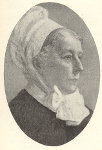
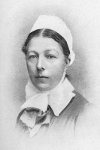 Isabella Gilmore
(1842-1923) was William Morris' sister. She
trained as
a nurse, and was encouraged by Bishop Thorold of Rochester to pioneer
deaconess work in South London [Southwark diocese was not created until 1905]. At first she was reluctant, but was
made deaconess in 1887, and set up a training house in Park Hill,
moving to premises on Clapham Common North Side in 1891 - her brother
designed the chapel and she, being practical, fixed the drains. This
handsome
18th century house had been built, as 'The Sisters', for John Walter,
founder of The
Times;
it was later renamed Gilmore
House in
her memory. Many women trained here for parish ministry. When it closed
in 1970, it became flats for overseas students and families, and is now
a 'luxury' development. The Isabella Gilmore Fund continues to
support women called to ministry in Southwark diocese.
Isabella Gilmore
(1842-1923) was William Morris' sister. She
trained as
a nurse, and was encouraged by Bishop Thorold of Rochester to pioneer
deaconess work in South London [Southwark diocese was not created until 1905]. At first she was reluctant, but was
made deaconess in 1887, and set up a training house in Park Hill,
moving to premises on Clapham Common North Side in 1891 - her brother
designed the chapel and she, being practical, fixed the drains. This
handsome
18th century house had been built, as 'The Sisters', for John Walter,
founder of The
Times;
it was later renamed Gilmore
House in
her memory. Many women trained here for parish ministry. When it closed
in 1970, it became flats for overseas students and families, and is now
a 'luxury' development. The Isabella Gilmore Fund continues to
support women called to ministry in Southwark diocese.
 In 1909 St Christopher's College, Blackheath
was founded by the Revd William Hume Campbell to train RE teachers for
day and Sunday schools. The one (later two) year certificate course
combined theology (biblical study, doctrine, church history and 'prayer
book') with the theory and practice of education (including psychology,
teaching methods, Sunday School organisation and the history of
education). It tended to attract middle-class women, some from
independent schools. Some worked as diocesan Sunday School organisers,
supporting volunteers; others became missionaries in various parts of
the Empire (including the western Canadian frontier). One distinguished
alumna was the late Margaret Kane, the first female industrial chaplain
(in Sheffield) and later adviser on social and industrial affairs to
successive Bishops of Durham; she was ordained deacon at the age of 73,
and priest at 80. On closure, in 1971 the college became an educational
trust, part of the Association of Church College Trusts linked to the National Society
promoting RE in accordance with the principles of the Church of
England, in parishes and schools, with an annual income of about £100k.
In 1909 St Christopher's College, Blackheath
was founded by the Revd William Hume Campbell to train RE teachers for
day and Sunday schools. The one (later two) year certificate course
combined theology (biblical study, doctrine, church history and 'prayer
book') with the theory and practice of education (including psychology,
teaching methods, Sunday School organisation and the history of
education). It tended to attract middle-class women, some from
independent schools. Some worked as diocesan Sunday School organisers,
supporting volunteers; others became missionaries in various parts of
the Empire (including the western Canadian frontier). One distinguished
alumna was the late Margaret Kane, the first female industrial chaplain
(in Sheffield) and later adviser on social and industrial affairs to
successive Bishops of Durham; she was ordained deacon at the age of 73,
and priest at 80. On closure, in 1971 the college became an educational
trust, part of the Association of Church College Trusts linked to the National Society
promoting RE in accordance with the principles of the Church of
England, in parishes and schools, with an annual income of about £100k.